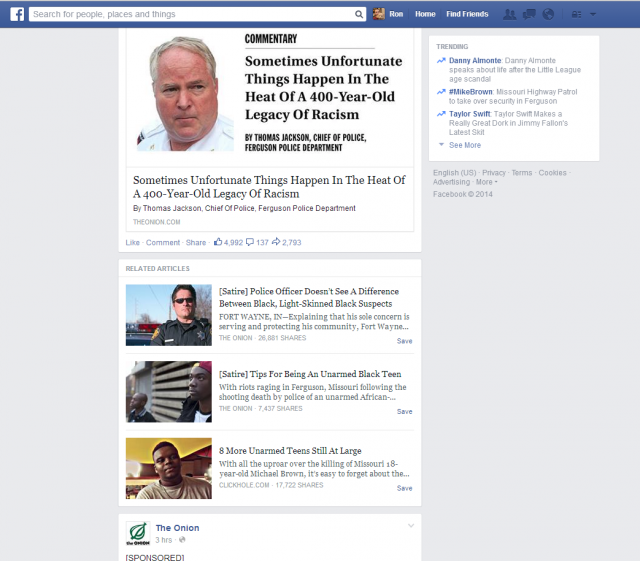
This week marks the 15th anniversary of the release of the band LFO's debut album, LFO. Short for "Lyte Funky Ones," LFO is the very definition of a one-hit wonder, and this is an appropriate time to celebrate that one hit, as August 1999 was also when that song, "Summer Girls" hit number three on the US Billboard charts.
Famed for basically just being a bunch of gibberish that rhymes, "Summer Girls" is one of the most inexplicable hits in US history. That said, the song has a bunch of nouns, which left us wondering: what did all of those nouns mean? Sounds like it's time for a complete annotation!
First, listen to the song to refresh your memory.
New Kids on the Block
What is this: A famed boy band from the late '80s and early '90s, NKOTB preceded LFO in the realm of writing anodyne pop music. LFO says they had "a bunch of hits" ("a bunch of" is LFO's favorite numerical modifier). Said hits include "Hangin' Tough" and "The Right Stuff."
Chinese food
What is this: Chinese food was perhaps best known to LFO in its Americanized form, served at so-called "Chinese restaurants" that are dotted throughout the United States. Usually a dish of meat and vegetables served over a bed of rice, Chinese food is a popular ethnic cuisine in the US. LFO may have eaten it at such fine dining establishments as Panda Express or PF Chang's.
Abercrombie & Fitch
What is it: A popular clothing chain in US malls in the 1990s, Abercrombie & Fitch was best known for having clothes that popular kids might want to wear. This explains why LFO "likes girls that wear Abercrombie & Fitch." The implication is that only an attractive girl would wear Abercrombie & Fitch. It's possible LFO's view is skewed by the clothes being a status symbol.
Hip hop marmalade
What is this: This is literally incomprehensible gibberish. There is no such thing. But there should be.
Spic 'N Span
What is this: A popular household cleaner, Spic 'N Span was invented by two Michigan housewives. It continues to be sold to this day.
Larry Bird (left) and Magic Johnson, prior to the 1991 NBA season. (Photo by Andrew D. Bernstein/NBAE via Getty Images)
Larry Bird (Jersey 33)
Who is this: One of the greatest basketball players of all time, Larry Bird scored 21,791 points during his 13 seasons with the Boston Celtics. He had been long retired by 1999, so it might have made more sense for LFO to name-drop scoring leaders for the 1998-99 season, such as Shaquille O'Neal, Allen Iverson, or, of course, Shareef Abdur-Rahim. Once one considers that LFO hails from Fall River, Massachusetts, however, its Bird hagiography becomes more explicable.
Billy Shakespeare
Who is this: William "Billy" Shakespeare is roundly acclaimed as the greatest writer to ever have written in the English language. The author of numerous classic plays, including Hamlet, Romeo & Juliet, and King Lear, Shakespeare was also responsible for, in LFO's words, "a whole bunch of sonnets." More recently, This American Life host Ira Glass proclaimed Shakespeare unrelatable.
Sonnets
What is this: A famous poetic form. Written in iambic pentameter, sonnets follow a very specific line scheme and feature a "turn" or "volta" around the ninth of 14 lines. But have sonnets endured? How many people do you see writing sonnets today? And how many people write gibberish? "Summer Girls" FTW.
Willie Whistle
Who is this: Most likely, LFO is referring to a clown with a high-pitched voice who served as a children's host on Boston's WSBK. It is also possible this lyric refers to the National Highway Traffic Safety Administration children's character "Willie Whistle." Much, much less likely is that this lyric refers to penis-shaped whistles sometimes given out as party favors, but one never knows.
Macaulay Culkin
Who is this: The star of the first two Home Alone films and several other movies, Culkin saw his popularity fade after he hit puberty. Most recently, Culkin was in a Velvet Underground cover band that turned songs by the group into songs about pizza.
Home Alone
What is this: The aforementioned film that brought Culkin to fame. It concerns a young boy who is left "home alone" when his family accidentally leaves him behind over the Christmas holidays. He has to protect his home from burglars. The film grossed over $285 million at the US box office upon its release in 1990.
Michael J. Fox
Who is this: The star of Family Ties and Back to the Future, Fox was riding high in 1999, upon his return to TV in the show Spin City. He remains a beloved figure to this day, even if his recent sitcom, The Michael J. Fox Show, was swiftly canceled. His visibility as someone with Parkinson's disease has done much to boost awareness of the condition.
Alex P. Keaton
Who is this: Fox's Family Ties character is considered the fictional standard-bearer of the 1980s Reagan revolution. The ultra-conservative son of liberal parents, Fox won four Emmys for playing him.
Cherry Pez
What is this: A cherry-flavored version of the popular, tiny hard candies that are usually housed in "Pez dispensers," which are usually shaped like cartoon characters.
Cold Crush
What is this: Most likely, LFO refers here to the seminal early hip-hop group "The Cold Crush Brothers," best known for their 1984 single "Fresh, Wild, Fly and Bold." The group is often held up as an example of record company exploitation of early hip-hop artists, though it seems incredibly unlikely LFO is referring to this serious issue in "Summer Girls."
Rockstar Boogie
What is this: This also seems to be gibberish. There's a musical artist named Rockstar Boogie, but he seems to post-date this song. Maybe he has LFO to thank for his name.
Here is a b-boy. (de2marco / Shutterstock.com)
B-Boy Style
What is this: Is LFO's "Summer Girls" an early example of bland white people appropriating hip-hop culture to seem cooler than they actually are? Quite possibly. But at least LFO knows that the more mainstream term of "breakdancing" isn't as widely acknowledged within the hip-hop community as "b-boying." Who knows why the word "style" is thrown in here, as no one in LFO dresses or dances like a b-boy.
New Edition
What is this: One of the earliest "boy bands," New Edition was an important progenitor of groups like the New Kids and, yes, LFO. Also, the R&B group came from Boston, which seems like a key distinction for LFO, whose members apparently don't mind entirely living up to popular stereotypes of Bostonians. Among New Edition's members was Bobby Brown.
"Candy Girl"
What is this: One of New Edition's earliest hits, "Candy Girl" is an infectious good time. Watch the group perform the song on Soul Train here.
Georgia
What is this: Here, LFO refers to the American state, whose capital, Atlanta, is an important hub of US commerce, rather than the country Georgia. We know this because LFO refers to Georgia in connection to "peaches," and peaches have a stronger association with the US Georgia than the country. Also, we're doubting that LFO ever thought much about the country Georgia.
Peaches
What is this: A popular summertime fruit, peaches are often best served with a little ice cream. Enjoy them on your back porch on a lazy August evening, the sky rolling over with clouds that will become a thunderstorm later. It's what LFO would want.
Mmmm... ice cold lemonade. (Shutterstock.com)
Lemonade
What is this: This drink is made by combining simple syrup with lemon juice to create a sour yet sweet beverage that is heavily associated with the summertime. Should you wish to make your own lemonade, Real Simple has four recipes.
Hip hop
What is this: The dominant musical style in the United States at the moment, hip hop came into prominence as rap, and while it is still primarily dominated by that form, it also features elements of R&B, soul, and pop. Some of the most popular hip hop artists of the past several years include Jay Z and Kanye West.
Rock 'n roll
What is this: Generally considered to have begun with the release of Bill Haley and the Comets's "Rock Around the Clock," which the group recorded in 1954. Heavily influenced by the blues, jazz, country, and other early 20th century music forms, rock 'n roll generally features small groups heavy on guitar and a pronounced backbeat. In case you haven't heard, it's dead. "Summer Girls" killed it.
Dad
Who is this: The male parent of a child, usually biological, but occasionally adopted. In "Summer Girls," the summer girl's dad skipped town, which makes him a jackass and gives this song its poignancy.
Paul Revere
Who is this: Famed for his late night ride, immortalized in a poem by Henry Wadworth Longfellow, Paul Revere rode from Boston to Lexington in April of 1775, warning those loyal to the revolutionary cause that the British were coming. He was also responsible for the phrase "one if by land, two if by sea," the latter half of which is a terrible Denis Leary movie. His father was named Apollos Rivoire, which is a great name, and this is just another Massachusetts reference in this song. Let it go, LFO.
Fun Dip
What is this: Originally known as Lik-M-Aid, Fun Dip is basically flavored sugar directly dispensed to kids. To consume it, tear open the pouch, pull out the edible utensil, and coat it in your saliva. Then dip it into the sugar and lick the sugar off the stick. Sounds gross when we put it that way, huh?
Cherry Coke
What is this: The popular beverage Coca Cola, mixed with cherry flavor. Originally, it was just Coke mixed with grenadine, but since 1985, Coke bottlers have offered the drink in bottle, can, and fountain form.
Boogaloo Shrimp
Who is this: He played Turbo, one of the most popular characters in the film Breakin' and its sequel Breakin' 2: Electric Boogaloo. Michael "Boogaloo Shrimp" Chambers was a breakdancer back when it was still sort of okay to refer to it as breakdancing. His routines are still fun to watch.
Pogo sticks
What is this: A vertical mode of transportation that involves the traveler standing upright on a stick with a spring attached to its bottom. The user's feet are planted on a bar along the bottom of the stick, followed by bouncing along on the spring. It is not a terribly efficient mode of travel.
Mr. Limpet
Who is this: Played by Don Knotts, Mr. Limpet was a man who wished to become a fish, then somehow got his incredibly lame wish granted when he fell into the water one day. From there, he worked with the US Navy to defeat the Axis in World War II. We wish we were making the plot of this movie up. Many have tried to mount a remake of the film — most recently Boyhood director Richard Linklater — but it has yet to happen.
The color purple
What is this: It's hard to know if LFO refers to the acclaimed novel by Alice Walker, which was also made into a film directed by Steven Spielberg, or the actual color purple, which resides on the blue-ish end of the spectrum and is created in the children's book The Color Kittens by mixing red and blue. But because this is immediately followed by "macaroni and cheese," we're guessing it means the latter. The former would be messed up.
Macaroni and cheese
What is this: An enormously popular dish, this usually involves elbow macaroni coated in a kind of cheese cream sauce. Or, more likely, it means the boxed dinner from Kraft foods, which you might remember from your childhood. We would like some right now. Please make it for us.
Ruby red slippers
What is this: Worn by Dorothy on her feet throughout the classic 1939 film The Wizard of Oz (though, pointedly, not in the book it was based on), the ruby red slippers allow Dorothy to return home by clicking her heels together and saying "There's no place like home." She stole them from a witch she killed by dropping a house on her. We would very much like to go home this deep into this article.
A bunch of trees. (Shutterstock.com)
A bunch of trees
What is this: Coniferous or deciduous, trees are among our most persistent, hardiest forms of plant life. You probably saw one today, though it's possible you did not see "a bunch of" them. "A bunch of" is reserved exclusively for LFO.
Kevin Bacon
Who is this: Star of many popular films and the abhorrent TV series The Following, Kevin Bacon was probably best known at the time of "Summer Girls's" release thanks to the "Six Degrees of Kevin Bacon" game, in which one attempts to connect any actor on Hollywood to Kevin Bacon via six moves or less.
Footloose
What is this: A film about a young man who moves to a small town and teaches the people there about the wonders of dancing, getting them to loosen up about that one time some kids died in a car accident. That young man? Played by Kevin Bacon, so LFO is really pulling it all together. (Also, possibly, the Kenny Loggins theme to this movie, though this seems less likely.) Like Bacon's character in the film, LFO came to bring us a funkier future, but we rejected them and live only in the distinctly unfunky present.
There. Now you have a complete annotated "Summer GIrls." Do with it what you will.













 I'm not sure if there are computers in these boxes, but if so, that's a dangerous game. Still, it's probably worth it for the sense of accomplishment you'd feel after pulling something like this off, right?
[Photo credit: Imgur]...
I'm not sure if there are computers in these boxes, but if so, that's a dangerous game. Still, it's probably worth it for the sense of accomplishment you'd feel after pulling something like this off, right?
[Photo credit: Imgur]...












